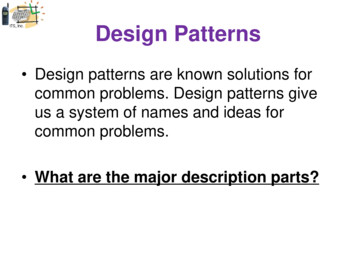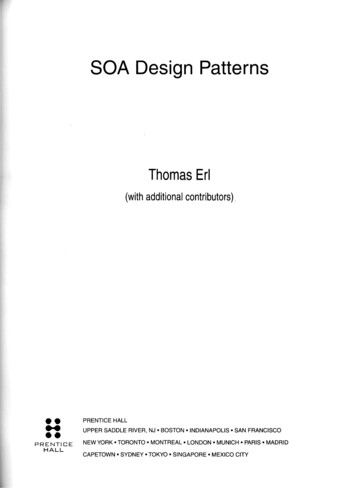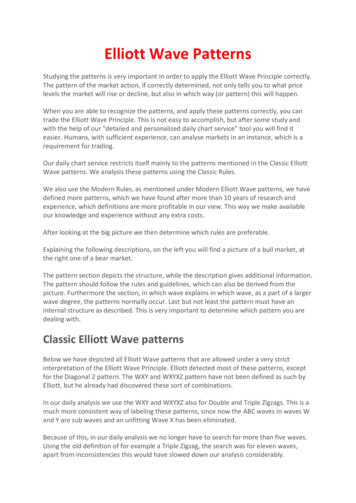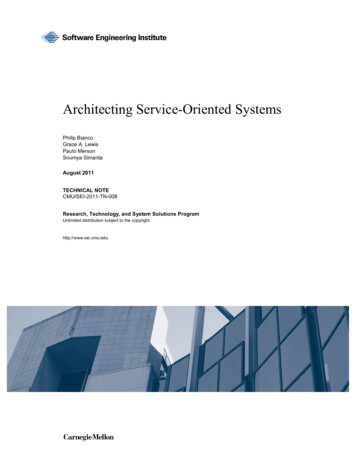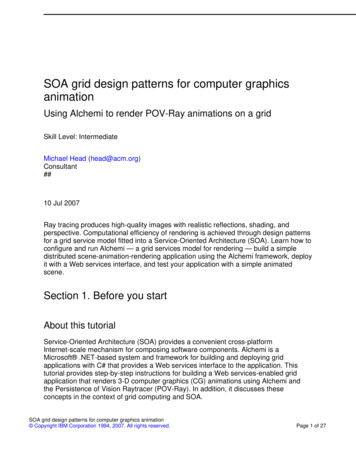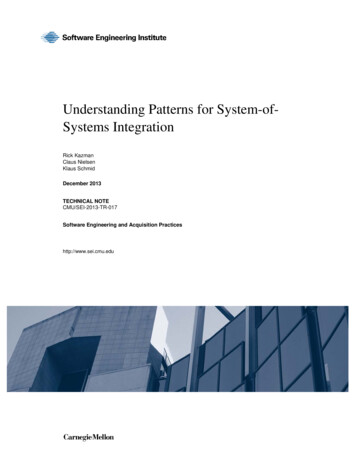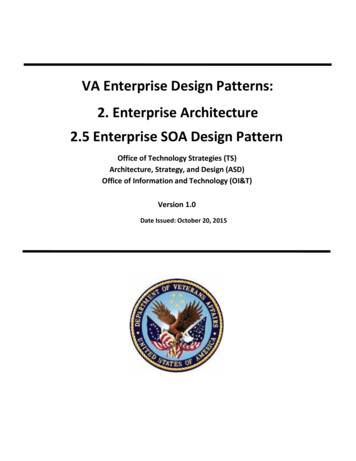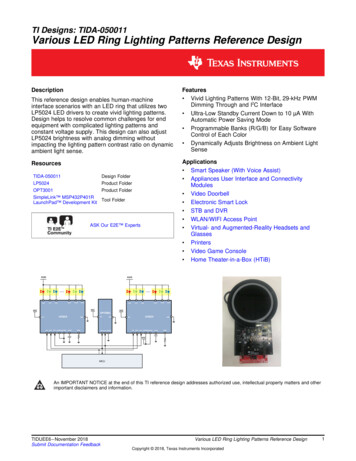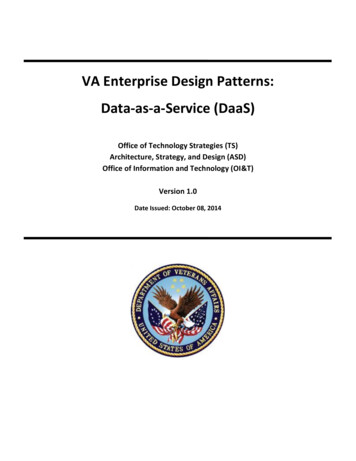
Transcription
VA Enterprise Design Patterns:Data-as-a-Service (DaaS)Office of Technology Strategies (TS)Architecture, Strategy, and Design (ASD)Office of Information and Technology (OI&T)Version 1.0Date Issued: October 08, 2014
THIS PAGE INTENTIONALLY LEFT BLANK FOR PRINTING PURPOSES
APPROVAL COORDINATIONDigitally signed by TIMOTHY L MCGRAIL111224DN: dc gov, dc va, o internal, ou people,0.9.2342.19200300.100.1.1 tim.mcgrail@va.gov, cn TIMOTHY L MCGRAIL 111224Date: 2014.10.14 09:29:00 -04'00'TIMOTHY LDate:MCGRAIL 111224Tim McGrailDeputy Director (Acting)ASD Technology StrategiesPAUL A. TIBBITSDate:116858Digitally signed by PAUL A. TIBBITS 116858DN: dc gov, dc va, o internal, ou people,0.9.2342.19200300.100.1.1 paul.tibbits@va.gov,cn PAUL A. TIBBITS 116858Reason: I agree to specified portions of this document.Date: 2014.10.28 17:38:46 -04'00'Paul A. Tibbits, M.D.DCIO Architecture, Strategy, and Design
REVISION 406/20/14ASD TSASD TS0.7508/25/14ASD TS0.8509/12/14ASD TS0.8809/12/14ASD TS0.9509/25/14ASD TS0.9809/29/14ASD TS1.010/08/14ASD TSInitial DraftInitial Draft for review/feedback from internal andexternal stakeholders2nd Draft for review/feedback from internal andexternal stakeholdersUpdated draft addressing concerns from internal andexternal stakeholders, including a revised structure tocapture key concepts and attributes associated withDaaS.Additional updates made based upon vendor feedbacksubmitted after distribution of v0.85. Providesclarification content and terminology updates andgrammatical fixes.Final draft version for review/comment by internal VAstakeholders. Updates include changes to languagearound “centralized/decentralized” data, explanation ofuse of approved VistA Evolution SOA design patternuntil a planned incremental update is made, change toVistA Evolution design pattern to highlight DaaScomponents, and update to Data Security sectionsaddressing confusion around VA 6500 Handbookencryption issues raised during public forum.Updated draft document to include finalized use casedocumentsUpdated final document based upon last round ofinternal stakeholder comments as well as TS leadershipreview.REVISION HISTORY line Meadows-StokesASD TS SOA DaaS Design Pattern Lead0.6006/20/14Jacqueline Meadows-StokesASD TS SOA DaaS Design Pattern 409/25/1409/29/1410/08/14Jacqueline Meadows-StokesJacqueline Meadows-StokesJacqueline Meadows-StokesJacqueline Meadows-StokesJacqueline Meadows-StokesJacqueline Meadows-StokesASD TS SOA DaaS Design Pattern LeadASD TS SOA DaaS Design Pattern LeadASD TS SOA DaaS Design Pattern LeadASD TS SOA DaaS Design Pattern LeadASD TS SOA DaaS Design Pattern LeadASD TS SOA DaaS Design Pattern Lead
TABLE OF CONTENTS1.Introduction . 61.1. Background . 61.2. Purpose. 71.3. Scope . 71.4. Intended Audience . 71.5. Document Development and Maintenance . 82.Design Pattern Key Concepts . 82.1. Data Access . 82.2. Database Management Systems (DBMS) . 92.2.1.Relational Databases . 92.2.2.NoSQL Databases . 102.2.3.Hybrid (NoSQL and Relational). 102.3. Authoritative Data Sources. 103.Design Pattern “To-Be” Architecture . 113.1. Alignment to VistA Evolution SOA Design Pattern . 113.2. Data-as-a-Service (DaaS) Attributes . 133.2.1.Data Aggregation. 133.2.2.Create, Read, Update, Delete (CRUD) Operations . 133.2.3.Scalability and Elasticity . 143.2.4.Capacity Management. 143.2.5.Data Security . 153.2.6.Troubleshooting . 163.2.7.Data Validation . 163.3. Enterprise DaaS Constraining Principles and Strategic Guidance . 16Appendix A. Use Cases . 18User/Application Access to Data through Relational Database Service . 18User/Application Access to Data through NoSQL Database Service . 19User/Application Access to Data through Hybrid Database Service . 20Appendix B. Vocabulary . 23Appendix C. Applicable References, Standards, and Policies . 24
1. INTRODUCTION1.1.BackgroundData-as-a-Service (DaaS) represents a capability that enables applications to obtain seamless access toenterprise data stores in a standardized way, while shielding them from the complexity of theirimplementations. It is based on the concept that data can be provided on demand to users through webservices regardless of the organizational separation of service providers and consumers.Within VA, IT programs have experienced problems accomplishing enterprise-wide data sharing due tothe development of self-contained applications that access application-specific data stores. In manycases, these data stores required proprietary and/or custom software to access and display data, whichoften constrains users to proprietary standards. Solutions in these cases typically included a softwarebundle comprised of a data store and the application(s) needed to access the data. Implementation andsustainment of these solutions left programs in a state of vendor lock-in in order to maintain theirapplications. Additionally, many programs developed applications tightly coupled to specific datastores, resulting in difficult troubleshooting and increasing maintenance challenges as the data storeschanged over time. The diagram below provides a notional services “layer cake” representation of the“as-is” state of the VA application development environment. It is meant to specifically highlight thedata layer within VA’s IT infrastructure, indicating the existence of data stovepipes and silos (redrectangles).Figure 1 – Notional Representation of VA “As-Is” State Involving Enterprise Data-as-a-Service (DaaS)VA is planning and executing the evolution of its IT architecture from a set of stove-piped systems to anintegrated, modern service oriented architecture (SOA) environment. This evolution will involve designPage 6
approaches that support the modernization of existing applications as well as future implementations ofnew applications that share enterprise services and data using the VA SOA infrastructure to accessenterprise data. DaaS will be realized through SOA-based data services in conjunction with additionalEnterprise Shared Services (ESS) and data management tools (MDM, ETL, etc.), that will enable dataquality to be maintained at a standardized enterprise level, cleansing and enriching data and making itavailable to different systems, applications, and users on demand. DaaS will aid in simplifying andaccelerating application development, eliminating data silos by enabling enterprise-wide data sharingand allowing VA to address challenges with respect to linking various types of customer data and viewsthrough a shared enterprise Virtual Data Access Layer (e.g., Health, Benefits, Corporate, and Memorials).1.2.PurposeThe purpose of this document is to provide strategic direction for the VA to establish a capability forstandardized access for multiple applications to enterprise data stores.In the target VA ITenvironment, enterprise storage, retrieval, and exchange of data will be achieved through the reuse ofESS provided by the VA’s SOA infrastructure, which includes the Enterprise Messaging Infrastructure(eMI). These services will include standardized interfaces for enterprise data access, including Create,Read, Update, Delete (CRUD) operations on enterprise data stores. Additionally, these services willinclude other key attributes such as data aggregation and data validation, as explained in Section 3.1.3.ScopeThe following sections of this first increment DaaS Design Pattern document will present high-levelconstraints for enabling enterprise data access within VA. It describes key DaaS capability attributes,including the use of ESS, for supporting virtual data access that will be available for all applications. Thedocument addresses: DaaS key concepts and context (Section 2) DaaS “to-be” architecture attributes (Section 3) Descriptions of VA-specific DaaS use cases (Appendices B) Applicable technical references, standards, and policies (Appendix D)The following content is beyond the scope of this document, but may be referenced in appropriatelocations to guide further technical planning and coordination with appropriate stakeholders: Implementation details for application integration with ESS Infrastructure and hardware design specifications Details for specific database technologies List of authoritative data sources and standards1.4.Intended AudienceThe document will be used by all programs to guide them towards the use of ESS for standardized,enterprise-wide access to enterprise data. This will help programs meet data sharing requirementsutilizing enterprise data stores while:Page 7
1.5.Developing new VA applications internallyModifying existing production systemsAcquiring and integrating COTS (including open-source) applicationsDocument Development and MaintenanceThis document was developed collaboratively with internal stakeholders from across the Departmentand included participation from VA’s Office of Information and Technology (OI&T), ProductDevelopment (PD), Office of Information Security (OIS), Architecture, Strategy and Design (ASD), andService Delivery and Engineering (SDE). In addition, the development effort included engagements withindustry experts to review, provide input, and comment on the proposed pattern. This documentcontains a revision history and revision approval logs to track all changes. Updates will be coordinatedwith the Government lead for this document, who will also facilitate stakeholder coordination andsubsequent re-approval depending on the significance of the change.2. DESIGN PATTERN KEY CONCEPTSThe rise of SOA has rendered the actual platform on which data resides less relevant. SOA assumesdistributed resources and use of those resources without knowing the details of their implementations.As such, it sets the stage for more generic services that do not need to expose those implementationdetails. This applies equally to data services.DaaS provides enterprise-level shared services for standardized access to enterprise data stores that areavailable across multiple applications. This section provides high-level overviews of key conceptsassociated with DaaS that are applicable to solving the recurring problems within the current state ofthe VA IT environment, as described in Section 1 (Background). These concepts provide the context forthe DaaS “to-be” architectural attributes that are described in Section 3, which will guide theestablishment of design constraints that will be applied to solution architectures developed by allprograms in the VA.2.1.Data AccessDaaS will enable applications to use enterprise-wide data access services to interact with enterprise datastores. These are intended to be simple, yet coarse-grained services that provide the ability to performCRUD operations on a single data store, as well as federated services that leverage multiple CRUDoperations performed across multiple data stores. Overall, these services abstract the logic required toaccess underlying data stores via a common data access layer, making application development,configuration and maintenance easier to sustain. Additionally, these services will support datainterchange functionality (sometimes referred to as “service agents”) when an application must accessdata provided by an external service. It is important to understand that well-designed user interfaces(whether on a PC or mobile device) should never physically interact directly with databases.Page 8
DaaS will be accessible through Enterprise Shared Services (ESS) that will enable seamless data access inaccordance with the “to-be” attributes described in Section 3. These services will align to theInformation Services category in the ESS layered architecture construct, as derived from the Open GroupSOA Reference Architecture. Moreover, they will be generally applicable across business domains,compared to a more domain-specific business process service. The use of these services will: Decouple physical and logical locations and avoid unnecessary data replication Abstract physical data structures and syntax into views accessible through a common dataaccess layer Federate disparate data into useful composites Support data integration across both SOA and non-SOA applicationsAccess to these services will be subject to appropriate access control requirements and restrictions forsecurity, privacy, records management, and retention. This topic will be explored further in a futureenterprise design pattern document that addresses enterprise-level authorization and auditing.2.2.Database Management Systems (DBMS)There are a multitude of available database management systems (DBMS) that represent theenterprise’s data stores and there exist additional variations of these database types based upon thedata needs of a given consumer. For the development of this document, specific database types werecharacterized for enterprise DaaS delivery due to the data specific needs of VA. These database typesare referred to as NoSQL, Relational, and Hybrid throughout the remainder of this document and arewhat drove the development of this design pattern guidance. Use case information regarding theapplication of these database types is provided in Appendix B.2.2.1. Relational DatabasesRelational database management systems (RDBMS) are a very mature technology, allowing storage ofrelational (structured) data in flat two-dimensional tables in a row and column paradigm. The first usecase in Appendix B provides context on how an application may call an RDBMS through the eMI. Oncedata is landed within the RDBMS, it is most commonly accessed via the Structured Query Language (SQL)either directly via JDBC or ODBC connectivity, within a part of application logic or a stored procedure.Within the VA IT infrastructure, RDBMS leverage Structured Query Language (SQL) and are supported bytools in the Technical Reference Model (TRM) that enable the use of Data Access Objects (DAO) andObject-relational Mapping (ORM) to provide abstractions to physical database access. Currently, mostof the VA’s data stores are based on RDBMS technology, including the Corporate Data Warehouse(CDW), which uses SQL and Extract, Transform, and Load (ETL) batch operations to support businessintelligence (BI) applications. Programs are required by the ETA Compliance Criteria to evaluate theirdata modeling needs early in the system development lifecycle (SDLC), and determine whetherapplication data will be persisted in relational schemas or persisted (e.g., form-based data) in a databasethat allows for more flexible schemas, such as a NoSQL database.Page 9
2.2.2. NoSQL DatabasesNoSQL, or “Not Only SQL,” databases provide a mechanism for storage and retrieval of unstructureddata that doesn’t easily lend itself to being efficiently stored and retrieved in the traditional row andcolumns paradigm that RDBMS employ. NoSQL databases have come about as a result for a need tofind a new way to store and manage semi-structured and unstructured data assets as the worldcontinues to generate more data from unlimited data generating sources. The second use case inAppendix B provides context on how an application may call a NoSQL through the eMI. Motivations forthis approach include simplicity of design, horizontal scaling and finer control over availability. The datastructures utilized in NoSQL data stores (e.g. key-value, graph, or document) enables flexible datastorage capability, not requiring a rigid schema definition for defined tables, and capacity to adapt toincoming data without needing extensive tuning to maintain performance as data volume continues togrow. As with all technologies, NoSQL data stores excel in some places where RDBMS falls short andvice versa, which is why a complete migration to NoSQL is not a wise approach. Currently the VA ispursuing an enterprise NoSQL data store that may be used for persistence of unstructured data, whichmay include use cases such as Patient Generated Data (PGD) for mobile applications. This document willbe revised to reflect the status of enterprise NoSQL database availability in the VA.2.2.3. Hybrid (NoSQL and Relational)A hybrid database call represent a scenario involving the simultaneous processing of data requests toboth a RDBMS and NoSQL database. The third use case in Appendix B provides context on how anapplication may call an aggregate of both RDBMS and NoSQL databases through the eMI. Hybridscenarios leverage Not-Only SQL database technologies that are designed to meet the increasingvolume, velocity, and variety of data that organizations are storing, processing, and analyzing. Thiscategory may also include other categories of data stores that are non-relational by nature, such as flatfile repositories and even VistA, which includes implementations on non-relational database platformssuch as GT.M.DaaS implementation as an ESS enables access to a diverse range of available data across these threevarying database types within the enterprise environment, introducing the concept of and need forauthoritative data sources, as explained in the following subsection.2.3.Authoritative Data SourcesThe term authoritative data source refers to a recognized or official data source, or functionalcombination of multiple data sources, providing reliable and accurate data for subsequent use byconsumers. The concept of authoritative data sources aligns with the ongoing effort to streamline dataquality of all data sources in the VA and achieve the goal of establishing a trusted set of enterprise-widedata sources. The authoritativeness of data must be well established, documented, and maintainedprior to a commitment to specific set of data or authoritative data source solution(s). Data availabilityacross an enterprise environment presents the need for authoritative data sources that are subject toestablished policy and standards which ensure data quality and consistency. While the concept ofPage 10
authoritative data sources is introduced in this design pattern document, specific guidance associatedwith their identification and governance is out of scope. For additional details on authoritative datasources and VA information management policy requirements, see the draft VA Directive 6518:Enterprise Information Management.3. DESIGN PATTERN “TO-BE” ARCHITECTURE3.1.Alignment to VistA Evolution SOA Design PatternThis section describes the “to-be,” vendor-agnostic attributes of DaaS with respect to the approved SOAdesign pattern for the VA. Appendix B provides example use cases of how applications may use theseservices to make calls to an RDBMS, a NoSQL database, or a Hybrid aggregation that involves data fromboth an RDBMS and a NoSQL databases. There is an array of currently available data services being usedwithin VA today [e.g., Data Access Service (DAS), Veteran Relationship Management (VRM) CustomerRelationship Management (CRM), etc.]. Future increments of this document will provide greater detailson them, including when and how they are used.The target state for the DaaS capability supports service discovery, mediated interactions, anddecoupled transactions through the VA SOA infrastructure and ESS. DaaS is currently a subset of theoverarching FY14 SOA design pattern for VistA Evolution that was approved by the Deputy CIO,Architecture, Strategy, and Design (ASD) on 8 July 2014. The VistA Evolution design pattern was theinitial enterprise IT strategic guidance document created within the VA’s Technology Strategies Office. Ithas been the driver for the development of additional Enterprise SOA design pattern documentsaddressing aspects of: Authentication, Authorization and Audit, IT Service Management, and WebTechnologies Data Sharing, to date. This DaaS design pattern is one of the many existing or planned SOAdesign patterns and establishes the framework for the use of ESS and the common SOA infrastructure,including the eMI, across all applications, including those that shared data with VistA.To maintain consistency across design pattern documents, the following figure represents anintermediate revision of the current, approved SOA design pattern. It highlights the specificcomponents within that pattern pertaining to DaaS, which are shaded in orange and contained withinthe larger Data-as-a-Service rectangle. Updates to the SOA design pattern are currently underway tomove from a depiction of the SOA environment for VistA Evolution, to a more accurate representationof the full Enterprise SOA target vision for the VA IT infrastructure. The updated design pattern willshow the “to-be” vision for a common, enterprise SOA service layer that is available via the eMI andprovides access to the enterprise DaaS layer. Upon approval of that design pattern by the Deputy CIO,ASD, this DaaS design pattern document will be updated accordingly.Page 11
Figure 2 – VA Enterprise DaaS Context (Orange) Based on Approved FY14 VistA Evolution SOA Design PatternDaaS encapsulates portions of the existing approved SOA design pattern and represents an enterprisewide “data layer” that includes enterprise CRUD services for data access as well as the shared enterprisedata stores themselves (e.g., VistA, Health Data Repository, and the CDW). Applications will bedeveloped such that they will leverage ESS for security (via Identity and Access Management (IAM)Access Services) as well as common SOA capabilities via Enterprise Messaging Infrastructure (eMI), suchas service registry or messaging.Currently, the SOA design pattern permits development and deployment of CRUD services to providevirtual data access through service adapters or wrappers, thereby abstracting physical databaseimplementation logic. These services will be defined to be web services that provide the ability toperform CRUD operations on a single data store. Additionally, DaaS will allow for the development of acomposite set of CRUD services which leverage multiple CRUD operations performed across multipledata stores. These composite CRUD services may be used to support aggregation or manipulation ofdata that leverage a diverse set of data elements.Page 12
The design pattern for SOA in the VA will be revised in FY15 to ensure that the SOA capabilitiesframework is consistent across each business domain. The revision will include a more comprehensiveset of enterprise-wide capabilities available within the VA, including the runtime environment andservice containers for ESS. This DaaS design pattern will be revised to ensure proper alignment to theupdated framework with regard to enterprise CRUD services and enterprise data stores. The updateddesign pattern will also provide additional information on officially designated ESS that are promotedand deployed to meet the capability needs for DaaS in the VA.3.2.Data-as-a-Service (DaaS) AttributesThe following DaaS attributes have been identified as an initial set of key components involved inensuring an effective enterprise data-as-a-service capability. The content associated with each of theseattributes combines an understanding of the “as-is” VA IT infrastructure, knowledge of required internalVA and external government policy, and the application of industry best practices to create theenterprise-level constraints that will guide the realization of the “to-be” vision for VA enterprise Data-asa-Service. This descriptive language and constraining guidance was developed through collaborationwith both internal and external government and industry stakeholders.3.2.1. Data AggregationData aggregation allows for the use of one or more data sources to construct a usable business entityand account for combinations of structured data with semi-structured or unstructured data. To provideseamless virtual data access to consumer applications, DaaS will provide functions such as dataaggregation, data de-duplication/rationalization, and data synchronization through the use of enterpriseSOA infrastructure including the Enterprise Messaging Infrastructure (eMI). These functions will supportthe composition of responses from multiple data stores and provide a semantically harmonized,aggregate response to the end user. Appendix B describes example use cases for data aggregation(referred to as “Hybrid”) via both a relational (RDBMS) and NoSQL database.As of FY14, the VA is currently developing the VistA Exchange capability as an enterprise-wide dataaggregation service for the healthcare domain. VistA Exchange will provide ‘native federation’ of allappropriate longitudinal health record data. This means data from DoD systems, all VA sites, andeHealth Exchange partners will be aggregated, indexed and normalized (to the extent possible forspecific data sources) for use by point of care applications. Future deployments of ESS will enable dataaggregation capabilities for domains supporting the benefits, memorials, and corporate domains tosatisfy business needs internal and external to the VA.3.2.2. Create, Read, Update, Delete (CRUD) OperationsCreate, Read, Update, and Delete (CRUD) operations refer to all of the major functions that areimplemented in database applications, and they are the four basic functions of persistent storage.CRUD functionality can be implemented with an object database, an XML database, flat files, or customfile formats, for example.Page 13
In the “to-be” state for the VA infrastructure there will be shared data that will allow a standardized setof enterprise-wide CRUD operations for each of the Health, Memorials and Benefits domains. Currently,the following CRUD constructs will be permissible through DaaS: CRUD Interchange Operations: Requires the use of the ESB provided by the eMI to ensure datavalidation, audit logging, and access control due to the need for calling data access services to adatabase that is not owned by the application. Programs will need to assess applicationperformance for data calls passing through the message broker, as opposed to retrieving datathrough direct calls to data access services. Direct CRUD Operations: Provides a “fast track” for a direct call to data access services withoutthe use of the eMI. This scenario depends on business needs where routing messages throughthe eMI may hinder performance. An example involves making a direct call to data stores toobtain vital signs information in the operating room of the VA Medical Center (VAMC). Thisscenario may apply to new applications that may be able to make a direct call for CRUDoperations on a specific database, such as the Patient Generated Data (PGD) database. Futureversions of this design pattern will provide greater detail addressing the potential need forscenario specific implementations of local access control privileges that allow bypassing of eMI.3.2.3. Scalability and ElasticityScalability is the ability to add resources to a solution as the demand for that solution or the specificresources used by the solution increases. This can be done through added hardware resources orthrough using additional tuning capabilities inherent in the technology of which the system is comprised(i.e., utilizing compression capab
0.40 04/18/14 Jacqueline Meadows-Stokes ASD TS SOA DaaS Design Pattern Lead 0.60 06/20/14 Jacqueline Meadows-Stokes ASD TS SOA DaaS Design Pattern Lead 0.75 08/25/14 Jacqueline Meadows-Stokes ASD TS SOA DaaS Design Pattern Lead 0.85 09/12/14 Jacqueline Meadows-Stokes ASD TS
